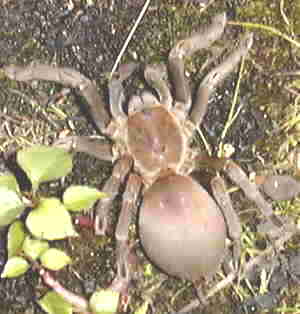 SKC Films Library SKC Films Library |
| SKC Films Library >> Science >> Zoology >> Arachnids >> Order Araneae |
| Goliath Bird-Eating Spider Theraphosa blondi, the world's largest spider Description The world's largest spider has a leg span of 12 inches across and can weigh 2.5 ounces. Its body is dark and light brown in color.
Distribution and Habitat This giant spider is found in wet swamps and marshy areas deep within the primary rainforest of Suriname, Brazil, Guyana, and Venezuela. Habits and Behaviors Goliaths live in deep burrows dug by the spiders themselves, or in burrows abandoned by rodents. The female spends most of her life in her silk-lined burrow. They are solitary, nocturnal, and seldom travel more than a few feet from their burrows. Unlike most other spiders, Goliaths can make a hissing noise to frighten off threats by rubbing bristles on its legs together. They will also rear up on their hind legs in a threat position. They do have two fangs, and they will bite, but their venom is not very toxic to humans. Their hairs are their most effective defense. These microscopically barbed hairs can be irritating to the skin and lungs, and can cause swelling that may last for several hours -- it is roughly equivalent to the discomfort caused by stinging nettles. Reproduction The female deposits about 50 eggs in a silken egg sack. She guards the sack for 6 to 7 weeks, going so far as to take it with her when she leaves the burrow to feed. After the spiderlings hatch they stay with (or on) their mother until their first molt, and then go out on their own. Female Goliaths can live up to 25 years in the wild. Males, however, live for only one year or less after mating. Diet Although it is easily large and powerful enough to catch them, and despite its name, the Goliath rarely eats birds, although it will eat hatchlings. Its usual diet consists of frogs, small snakes, beetles, insects, lizards, and even bats. Prey is usually seized by a sudden silent dash, after which it is injected with a paralyzing venom. Scientific Classification phylum Arthropoda |
| SKC Films Library
>> Science
>> Zoology >> Arachnids >> Order Araneae This page was last updated on May 19, 2017. |
